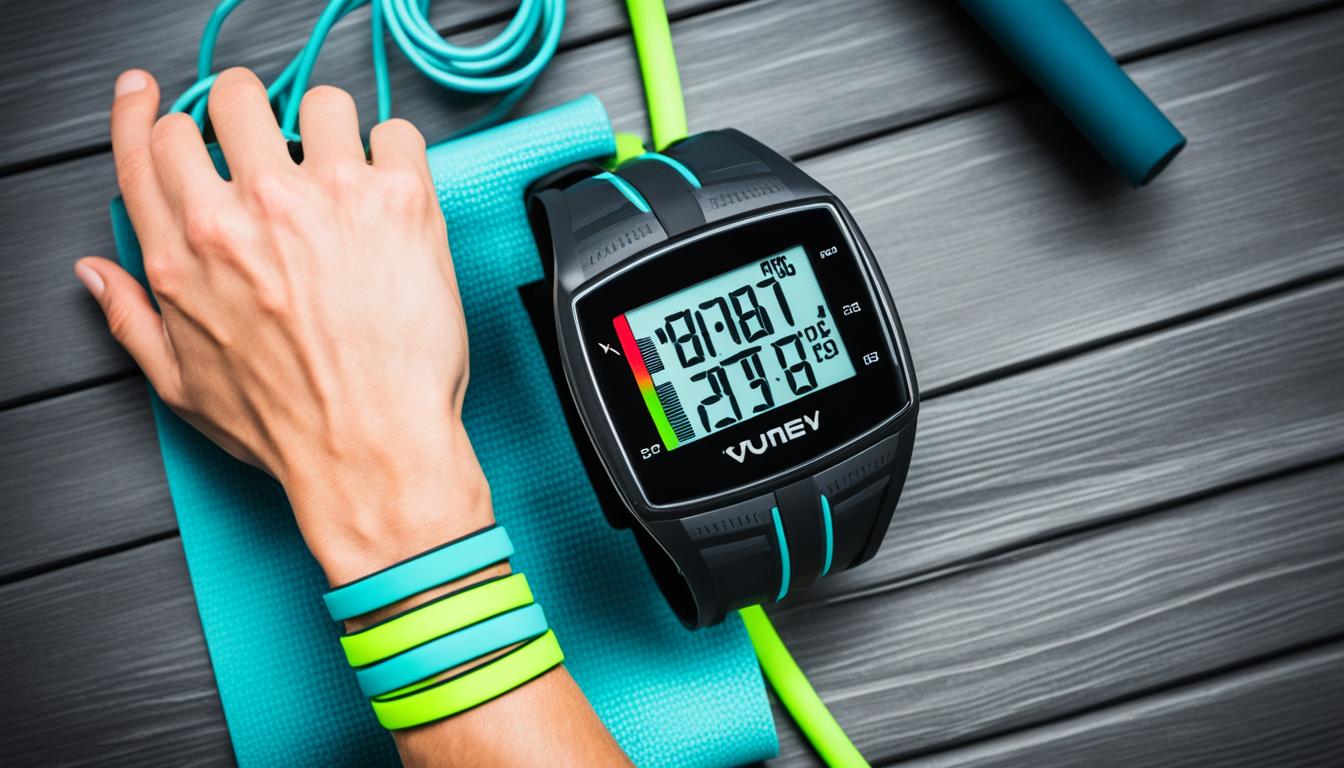Did you know heart disease causes one in every four deaths in the U.S.? This fact shows how important it is to keep an eye on heart health. Thanks to modern technology, heart rate monitors (HRMs) are now key tools in this task. They offer up-to-the-moment info on heart rate, steps, and how fast you’re running.
HRMs are vital in understanding how hard you’re working out, how much energy you’re using, and how fast you recover. As more people aim for a healthier lifestyle, the popularity of these devices grows. Using HRMs can help you get the most out of your exercises and watch your health closely.
Key Takeaways
- Heart disease is the leading cause of death in the U.S., making heart health monitoring crucial.
- Heart Rate Monitors (HRMs) offer real-time data on cardiovascular health.
- These devices have evolved into essential fitness gadgets for tracking workout intensity and energy expenditure.
- HRMs provide insights into overall health indicators, such as recovery rate.
- Incorporating HRMs can optimize the effectiveness of exercise routines.
Understanding Heart Rate Monitors
Heart rate monitors are key tools for athletes and those who love to stay fit. By tracking heartbeats, they give a clear picture of how hard you’re working out. They also show whether you’re burning fat or carbs, making your workouts better.
Definition and Functionality
Heart rate monitors work by showing your heart rate as you exercise. Measuring in beats per minute (BPM), they let you know the intensity of your activity. They do more than just show numbers; they tell you what kind of energy you’re using.
Different Types of Heart Rate Monitors
There are many heart rate monitors to fit your needs. Whether it’s a wearable device like an Apple Watch or a chest strap, they all have their perks. Wearables are easy to use and work well with apps. Chest straps give accurate heart rate data, perfect for intense workouts.
| Type | Examples | Main Features |
|---|---|---|
| Wearable Devices | Apple Watch, Fitbit | Convenient, integrates with fitness apps, suitable for daily use |
| Chest Strap Models | Polar H10, Garmin HRM-Pro | Highly accurate, ideal for high-intensity training, direct electrical activity measurement |
Benefits of Using Heart Rate Monitors in Your Workout
Using heart rate monitors (HRMs) in your workouts can really boost your fitness. They give you great insights about your heart health. They are key for anyone serious about using fitness tech.

Enhanced Performance Monitoring
HRMs offer live feedback on how your body is doing during exercise. They let you adjust your effort to stay in the right heart rate zones. This way, you track your heart health better and make sure your workouts are just right.
Optimizing Training Intensity
HRMs are great for setting the right workout intensity. They help you exercise smartly, so you neither push too little nor too much. This balance improves your stamina and strength, boosting your heart health.
| Feature | Benefit |
|---|---|
| Real-Time Heart Rate Tracking | Allows for immediate adjustments in workout intensity. |
| Heart Rate Zones | Helps to maintain optimal training intensity and burn calories efficiently. |
| Performance Feedback | Enhances overall workout quality by providing detailed insights. |
Adding HRMs to your fitness plan really elevates your workout. They ensure you exercise safely and effectively. This smart fitness tech boosts your performance and helps keep your heart healthy.
How to Choose the Right Heart Rate Monitor
Choosing the right heart rate monitor (HRM) involves considering your fitness goals. Whether you prefer fitness trackers or chest strap models, both are great. They offer features that match different needs for comfort, accuracy, and ease of use.
Fitness Trackers vs. Chest Strap Models
Fitness Trackers: Worn on the wrist, they monitor your heart rate all day. Brands like Fitbit and Apple add cool features. These include step counting, sleep tracking, and alerts, making them handy and versatile.
Chest Strap Models: These are super accurate. They measure heartbeats directly and suit athletes and fitness lovers. Models like the Garmin HRM-Pro stay put, offering constant data during tough workouts.
Features to Consider
Important features to consider in HRMs include:
- Real-time Tracking: This allows you to adjust your workout as you go.
- GPS: Great for tracking your runs or bike rides precisely.
- Compatibility: Make sure it works with your other gear and tech gadgets.
Top Brands and Recommendations
Many brands provide HRMs for various needs:
- Apple Watch: It’s perfect for those who love tech and fitness.
- Garmin: Their chest straps, like the Garmin HRM-Pro, are ideal for the serious exerciser.
- Fitbit: They offer everything from simple trackers to advanced health monitors.
Heart Rate Zones: What They Are and How to Use Them
Heart rate zones are key for making effective workout plans. They guide you to tune your exercise intensity. This leads to reaching fitness targets smoothly.
Finding Your Maximum Heart Series
To find your maximum heart rate, there’s an easy method: 220 minus your age. This number is the peak beats per minute (BPM) your heart can handle when you push yourself the hardest. It helps in planning your training intensity for different zones.
Targeting Specific Zones for Optimal Results
Heart rate zones go from gentle to all-out effort. Each has its own benefits for your fitness. Here’s a quick guide:
- Low Intensity (50-60% of Max HR): Great for getting started or winding down. It boosts heart health without too much stress.
- Moderate Intensity (60-70% of Max HR): Builds stamina and burns fat in a balanced way, keeping effort under control.
- High Intensity (70-85% of Max HR): Aims to up your heart health and burn more calories. It’s good for a robust workout.
- Maximum Intensity (85-100% of Max HR): For intensive bursts in your routine, like HIIT. It helps increase speed and strength.
Focusing on these zones lets you shape your exercise to hit goals like boosting endurance or burning calories. Using heart rate data keeps your training on point for top results.
Heart Rate Monitors: Essential Tool for Training Intensity
Heart rate monitors (HRMs) are crucial for today’s workouts. They show your beats per minute (BPM) as you exercise. This tells you how much effort you’re putting in.
With these readings, HRMs tell you when to push your limits or take it easy. They help improve your performance by using your heart rate.

HRMs are a must-have for those looking to burn fat, boost endurance, or do intense training. They make sure you’re exercising in the right heart rate zone. This makes your workouts more productive and safer, reducing the chance of getting hurt.
Using HRMs steps up your training game. They give feedback that helps you train smarter and reach your goals. For those serious about getting better at their fitness game, a good heart rate monitor is key.
| Training Goal | Heart Rate Zone | Benefits |
|---|---|---|
| Fat Burning | 60-70% of Max HR | Optimal for Burns Fat While Preserving Muscle |
| Endurance | 70-80% of Max HR | Improves Cardiovascular Health and Stamina |
| High-Intensity Training | 80-90% of Max HR | Boosts Aerobic and Anaerobic Fitness |
The Impact of Heart Rate Monitors on Cardiovascular Health
Heart rate monitors (HRMs) have changed the way we handle fitness and heart health. These devices give us live updates on our heart rates. This is crucial for knowing how our heart is doing during different activities or even when we’re not moving.

Monitoring and Improving Heart Health
Using HRMs regularly helps people watch over their heart health closely. They can spot any unusual heart rate patterns early. This could signal health problems needing a doctor’s check. Keeping an eye on heart rate trends over time helps make smarter choices about exercise and health care.
Preventing Overtraining and Injury
Heart rate monitors are great for avoiding too much training and injuries. They show how hard you’re working out by showing your heart rate. This way, you can make sure you’re not overdoing it. Staying within safe limits keeps the heart healthy and lowers the risk of injury.
Also, HRMs let people adjust their workouts to meet their heart health needs. By knowing their heart rate zones, they can have safer and more effective workouts. This makes HRMs essential for staying fit today.
- Enhanced cardiovascular monitoring
- Early detection of potential issues
- Safe workout intensity levels
- Optimized heart health
| Benefit | Description |
|---|---|
| Heart Health Monitoring | Track and analyze heart rate patterns to identify health issues |
| Prevent Overtraining | Maintain safe workout intensity to avoid injury |
| Optimized Workouts | Use personalized heart rate data for tailored exercise |
Integrating Heart Rate Monitors with Fitness Technology
Heart rate monitors (HRMs) combined with fitness tech mark a huge step in exercise and health tracking. By connecting these devices with wearables and apps, people get a better look at their fitness progress.
Wearable Devices and Smart Applications
Wearables like the Apple Watch, Garmin Forerunner, and Fitbit Charge have changed the fitness tech scene. They work smoothly with apps that log and analyze exercise details. With HRMs, users can check their heart rates during workouts and get feedback.
Real-Time Data Analysis and Tracking
Real-time data analysis shifts how people reach their fitness targets. Smart apps use algorithms to make sense of the data in a simple way. They show heart rate zones, calories burned, and recovery times. This helps users plan better workouts for top results.
This mix of HRMs and real-time analysis improves how people track their performance. It leads to smarter exercise plans. The rise of these tech tools is key to better health and fitness.
| Wearable Device | Smart Ypp | Key Features |
|---|---|---|
| Apple Watch | Apple Health | Heart Rate Zones, VO2 Max, Calorie Counting |
| Garmin Forerunner | Garmin Connect | Advanced Sleep Monitoring, Stress Tracking, Training Load |
| Fitbit Charge | Fitbit App | Continuous Heart Rate, Real-time GPS Tracking, Sleep Analysis |
Practical Tips for Using Heart Rate Monitors Effectively
Heart rate monitors (HRMs) are great tools for fitness. But, you need to know how to make them work for you. These tips will show you how to bring them into your fitness routine.
Setting Up and Calibrating Your Device
First, set up and calibrate your HRM as the instructions say. You’ll input details like your age, weight, and how fit you are. This makes sure you get data you can trust.
Correct calibration lets your device track your exercise better. This way, you know if you’re working out right or need to change things.
Interpreting Your Data
Knowing what your HRM’s data means is vital. It shows how hard you’re working out through different heart rate zones. This helps you make your workouts better.
If you see your heart rate is high for too long, you might need to rest. Or maybe just take it a bit easier. Paying attention to these details improves your workouts and health.
Conclusion
Heart rate monitors have changed our fitness approach greatly. They are now key tools for both fans and pros. These devices give live feedback on heart rate and performance. This lets users make better workout plans.
They blend well with today’s fitness tech. You can link them with wearables or apps for deep data insight. This helps in making personal fitness plans. They are crucial for setting the right workout intensity, improving performance, and preventing too much strain.
With a focus on better health and efficient workouts, a top-notch heart rate monitor is smart to have. They’re not just gadgets but vital for analyzing and boosting health and performance. For those dedicated to fitness, adding a heart rate monitor to your gear is a must.

